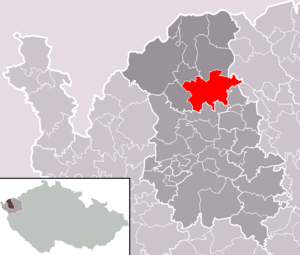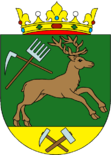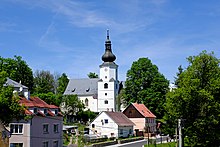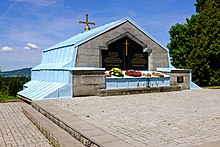Jindřichovice
| Jindřichovice | ||||
|---|---|---|---|---|
|
||||
| Basic data | ||||
| State : |
|
|||
| Region : | Karlovarský kraj | |||
| District : | Sokolov | |||
| Area : | 4439.689 ha | |||
| Geographic location : | 50 ° 17 ' N , 12 ° 36' E | |||
| Height: | 646 m nm | |||
| Residents : | 491 (Jan. 1, 2019) | |||
| Postal code : | 357 04 to 357 05 | |||
| License plate : | K | |||
| traffic | ||||
| Street: | Sokolov - Kraslice | |||
| structure | ||||
| Status: | local community | |||
| Districts: | 2 | |||
| administration | ||||
| Mayor : | Martina Majdáková (as of 2018) | |||
| Address: | Jindřichovice 232 358 01 Kraslice |
|||
| Municipality number: | 560413 | |||
| Website : | www.obecjindrichovice.cz | |||
| Location of Jindřichovice in the Sokolov district | ||||

|
||||
Jindřichovice ( German Heinrichsgrün ) is a former mountain town in the western Ore Mountains in Karlovarský kraj in the Czech Republic .
geography
Geographical location
The village is located in western Bohemia between 640 and 700 m on a plateau of the Nejdecka vrchovina ( Neudecker Bergland ), which forms the southwestern part of the Western Ore Mountains . Neighboring towns are in the southwest Oloví ( Lead City ), in the northwest Rotava ( Rothau ) and in the north Šindelová ( Schindlwald ). In the south, the spoil heaps of the lignite mine in the Falkenau basin near Dolní Nivy ( Unter Neugrün ) are about five kilometers away.
Community structure
The municipality Jindřichovice consists of the districts Háj ( Silbersgrün ) and Jindřichovice ( Heinrichsgrün ). Basic settlement units are Háj, Heřmanov ( Hermannsgrün ), Hradecká ( Scheft ), Jindřichovice, Loučná ( Waitzengrün ), Mezihorská ( Kührberg ), Poušť ( Oed ), Rác and Stará ( Altengrün ). The one-layer Smrčina ( Kronesberg ) also belongs to Jindřichovice .
The municipality is divided into the cadastral districts of Háj u Jindřichovic, Heřmanov v Krušných horách, Hradecká, Jindřichovice v Krušných horách, Loučná v Krušných horách, Mezihorská, Poušť and Stará.
Neighboring places
| Rotava (Rothau) | Šindelová (Schindl Forest) | |
| Oloví (lead city) |

|
Nejdek (Neudek), Černava (Schwarzenbach) |
| Dolní Nivy (sub-green) | Tatrovice (Dotterwies) |
history
Heinrichsgrün was first mentioned in 1273 in a document by Pope Gregory X. At that time the place belonged to the manor of the monastery Teplá . In 1340 Peter Plick von Plickenstein, the owner of the castle and town of Neudek , bought the place. From 1434 to 1672 Heinrichsgrün was owned by Count Schlick , under whom the town - like the neighboring Sankt Joachimsthal - experienced an economic boom. Tin, iron ore, lead and silver were mined.
In 1518 Heinrichsgrün was called "Bergstadt" (= mining town). In 1523 tin mining is mentioned for the first time near Heinrichsgrün and in 1525 two mining companies were based there. In 1537 confirmed Ferdinand I as king of Bohemia the market Heinrichsgrün the full Loket town charter . There is evidence of a brewery in the same year. At that time, Heinrichsgrün consisted of 55 properties that had to cede a guilder of hereditary interest to the rulers twice a year. In 1546 Heinrichsgrün received its own coat of arms. In 1592 a school building was built next to the old church. From 1601 to 1686 Heinrichsgrün kept his own mountain book.
In the course of the Counter-Reformation the Schlick had to sell the property to Otto von Nostitz in 1627 , who immediately provided Heinrichsgrün with a Catholic priest. However, the residents adhered to the Lutheran faith until 1641. In 1654 Heinrichsgrün had 75 inhabited houses, while 15 were empty. Their owners had probably left for reasons of faith. In 1794 a poor institute was established in Heinrichsgrün when the Maria Trost Brotherhood was drawn in. The last owner of the place until 1945 was Friedrich von Nostitz-Rieneck (1893–1973), married to Sophie von Nostitz-Rieneck , nee Princess von Hohenberg from the House of Habsburg, they lived in Salzburg-Aigen after the expulsion .
The mining of silver and lead was abandoned before the end of the 19th century. During the First World War in 1915 the Austro-Hungarian monarchy set up a prison camp, mainly for Serbian, Russian and Italian prisoners, near Heinrichsgrün. Around 28,000 prisoners had to work in the iron and mining operations, especially in Rothau and Chodau . Many of them died of starvation, exhaustion and, because of poor hygiene, also of epidemics. They were initially buried near the camp, some in mass graves. After the region was added to the newly created Czechoslovakia after the end of the war in 1919 , the then Czechoslovak government had a waterworks built by the prisoners converted into a mausoleum . Most of the bones were exhumed and buried there. Today there is a memorial there.
After the Munich Agreement , the place came to the German Reich and until 1945 belonged to the district Graslitz , administrative district Eger , in the Reichsgau Sudetenland . After the end of the Second World War , Czechoslovakia took over the region transferred to the German Reich in the Munich Agreement. In the period that followed, the German-speaking population was largely expropriated and expelled .
Population development
Until 1945 Heinrichsgrün was predominantly settled by German Bohemia , which were expelled
| year | Residents | Remarks |
|---|---|---|
| 1785 | k. A. | 181 houses |
| 1830 | 1,669 | in 262 houses |
| 1847 | 1,977 | in 267 houses |
| 1869 | 1,811 | |
| 1880 | 1,809 | |
| 1890 | 1,745 | |
| 1900 | 1,796 | German residents |
| 1910 | 1.911 | |
| 1921 | 1,726 | 1,673 of them are Germans |
| 1930 | 1,804 | |
| 1939 | 1,668 |
| year | 1950 | 1961 1 | 1970 1 | 1980 1 | 1991 1 | 2001 1 | 2011 1 |
| Residents | 617 | 779 | 551 | 394 | 318 | 386 | 472 |
The population figures given in the two tables refer to the respective territorial status.
Culture and sights
- Castle, built in 1672 by Johann Hartwig von Nostitz to replace the old Schlick fortress. It was rebuilt in the neo-Gothic style in the second half of the 19th century and is the seat of the Sokolov district archive (Státní Okresní Archive Sokolov)
- Mausoleum for former prisoners of war of the First World War. The remains of 189 Russians and approximately 7100 Serbs rest in the mausoleum.
- St. Martin's Church , a building from 1803 with an interesting octagonal tower.
Personalities
Sons and daughters of the church
- Wolfgang Schindler (around 1470–1538), theologian and university professor
- Balthasar Rösler (1605–1673), miner and excavator
Persons related to Heinrichsgrün
- Niklas von Globen († 1639), Bohemian nobleman, governor of Heinrichsgrün
- Johann Hartwig von Nostitz-Rieneck (1610–1683), Colonel Chancellor, owner of the estate
- Christoph Michael Hutschenreuther (around 1628–1707), hammer master, landowner
- Erwein von Nostitz-Rieneck (1863–1931), industrialist and politician, owner of the estate
literature
- Hermann Brandl : Festschrift for the 400th anniversary of the city of Heinrichsgrün. City of Heinrichsgrün, Heinrichsgrün 1937.
- Vinzenz Uhl: Castles and palaces of the Ore Mountains and Egertal. Kaaden, 1935. (Heinrichsgrün Castle)
Web links
Individual evidence
- ↑ http://www.uir.cz/obec/560413/Jindrichovice
- ↑ Český statistický úřad - The population of the Czech municipalities as of January 1, 2019 (PDF; 7.4 MiB)
- ↑ http://www.uir.cz/casti-obce-obec/560413/Obec-Jindrichovice
- ↑ http://www.uir.cz/zsj-obec/560413/Obec-Jindrichovice
- ↑ http://www.uir.cz/katastralni-uzemi-obec/560413/Obec-Jindrichovice
- ↑ a b Lubomír Zeman: Paths of Cultural Heritage. A travel guide through the important mining monuments of the western Ore Mountains (series Der Weg der Bergbaudenkmale ). Published by the National Monument Institute of the Czech Republic. Polypress, Karlovy Vary 2013, ISBN 978-80-87104-73-6 , p. 38.
- ^ Josef Weinmann: Egerländer Biographical Lexicon . With selected people from the former administrative district of Eger. Volume 2: N - Z. Weinmann, Männedorf / ZH 1987, ISBN 3-922808-12-3 , p. 24; Graslitzer news. 1, 1974, ZDB -ID 958738-x .
- ↑ a b Meyer's Large Conversation Lexicon . 6th edition, Volume 9, Leipzig and Vienna 1907, p. 111.
- ↑ Jaroslaus Schaller : Topography of the Kingdom of Bohemia . Volume 2: Ellbogner Kreis , Prague 1785, pp. 52-54, item 1) .
- ↑ Yearbooks of the Bohemian Museum of Natural and Regional Studies, History, Art and Literature . Volume 2, Prague 1831, p. 200, point 4).
- ↑ Johann Gottfried Sommer : The Kingdom of Bohemia . Volume 15: Elbogner Kreis , Prague 1847, p. 72.
- ^ Sudetenland Genealogy Network
- ^ A b Michael Rademacher: German administrative history from the unification of the empire in 1871 to the reunification in 1990. Graslitz district. (Online material for the dissertation, Osnabrück 2006).
- ↑ Historický lexikon obcí České republiky - 1869-2015. (PDF) Český statistický úřad, December 18, 2015, accessed on February 14, 2016 (Czech).




